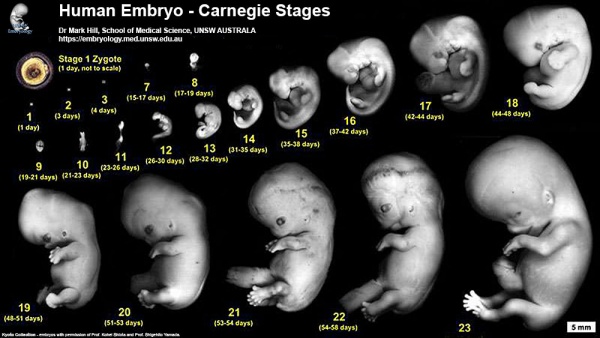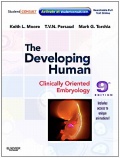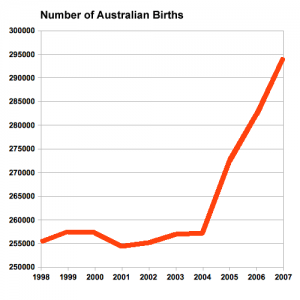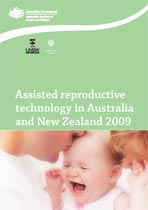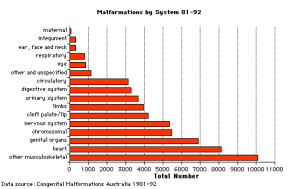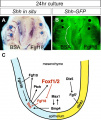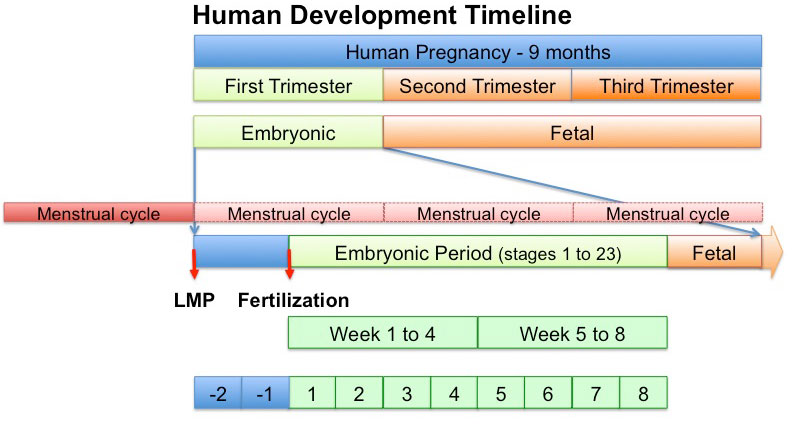Lecture - 2014 Course Introduction: Difference between revisions
mNo edit summary |
mNo edit summary |
||
| Line 39: | Line 39: | ||
Either of the textbooks listed below are recommended for this course and page references to both are given in each lecture. Both textbooks available at campus bookshop. There are additional embryology textbooks that can also be used, consult course organizer. See also [[Embryology Textbooks]] | Either of the textbooks listed below are recommended for this course and page references to both are given in each lecture. Both textbooks available at campus bookshop. There are additional embryology textbooks that can also be used, consult course organizer. See also [[Embryology Textbooks]] | ||
===The Developing Human: Clinically Oriented Embryology ( | ===The Developing Human: Clinically Oriented Embryology (9th ed.)=== | ||
{| | {| | ||
| [[File:The Developing Human, 9th edn.jpg|120px]] | | [[File:The Developing Human, 9th edn.jpg|120px]] | ||
| Line 49: | Line 49: | ||
| | | | ||
* [http://er.library.unsw.edu.au/er/cgi-bin/eraccess.cgi?url=http://www.mdconsult.com/books/page.do?eid=4-u1.0-B978-1-4377-2002-0..00001-1&isbn=978-1-4377-2002-0&uniqId=330028653-2#4-u1.0-B978-1-4377-2002-0..00001-1 Chapter 1 - Introduction to the Developing Human] | * [http://er.library.unsw.edu.au/er/cgi-bin/eraccess.cgi?url=http://www.mdconsult.com/books/page.do?eid=4-u1.0-B978-1-4377-2002-0..00001-1&isbn=978-1-4377-2002-0&uniqId=330028653-2#4-u1.0-B978-1-4377-2002-0..00001-1 Chapter 1 - Introduction to the Developing Human] | ||
* [http://er.library.unsw.edu.au/er/cgi-bin/eraccess.cgi?url=http://www.mdconsult.com/books/page.do?eid=4-u1.0-B978-1-4377-2002-0..00002-3&isbn=978-1-4377-2002-0&uniqId=330028653-2#4-u1.0-B978-1-4377-2002-0..00002-3 Chapter 2 – First Week of Human Development] | * [http://er.library.unsw.edu.au/er/cgi-bin/eraccess.cgi?url=http://www.mdconsult.com/books/page.do?eid=4-u1.0-B978-1-4377-2002-0..00002-3&isbn=978-1-4377-2002-0&uniqId=330028653-2#4-u1.0-B978-1-4377-2002-0..00002-3 Chapter 2 – First Week of Human Development] | ||
* [http://er.library.unsw.edu.au/er/cgi-bin/eraccess.cgi?url=http://www.mdconsult.com/books/page.do?eid=4-u1.0-B978-1-4377-2002-0..00003-5&isbn=978-1-4377-2002-0&uniqId=330028653-2#4-u1.0-B978-1-4377-2002-0..00003-5 Chapter 3 – Second Week of Human Development] | * [http://er.library.unsw.edu.au/er/cgi-bin/eraccess.cgi?url=http://www.mdconsult.com/books/page.do?eid=4-u1.0-B978-1-4377-2002-0..00003-5&isbn=978-1-4377-2002-0&uniqId=330028653-2#4-u1.0-B978-1-4377-2002-0..00003-5 Chapter 3 – Second Week of Human Development] | ||
* [http://er.library.unsw.edu.au/er/cgi-bin/eraccess.cgi?url=http://www.mdconsult.com/books/page.do?eid=4-u1.0-B978-1-4377-2002-0..00004-7&isbn=978-1-4377-2002-0&uniqId=330028653-2#4-u1.0-B978-1-4377-2002-0..00004-7 Chapter 4 – Third Week of Human Development] | * [http://er.library.unsw.edu.au/er/cgi-bin/eraccess.cgi?url=http://www.mdconsult.com/books/page.do?eid=4-u1.0-B978-1-4377-2002-0..00004-7&isbn=978-1-4377-2002-0&uniqId=330028653-2#4-u1.0-B978-1-4377-2002-0..00004-7 Chapter 4 – Third Week of Human Development] | ||
* [http://er.library.unsw.edu.au/er/cgi-bin/eraccess.cgi?url=http://www.mdconsult.com/books/page.do?eid=4-u1.0-B978-1-4377-2002-0..00005-9&isbn=978-1-4377-2002-0&uniqId=330028653-2#4-u1.0-B978-1-4377-2002-0..00005-9 Chapter 5 – Fourth to Eighth Weeks of Human Development] | * [http://er.library.unsw.edu.au/er/cgi-bin/eraccess.cgi?url=http://www.mdconsult.com/books/page.do?eid=4-u1.0-B978-1-4377-2002-0..00005-9&isbn=978-1-4377-2002-0&uniqId=330028653-2#4-u1.0-B978-1-4377-2002-0..00005-9 Chapter 5 – Fourth to Eighth Weeks of Human Development] | ||
* [http://er.library.unsw.edu.au/er/cgi-bin/eraccess.cgi?url=http://www.mdconsult.com/books/page.do?eid=4-u1.0-B978-1-4377-2002-0..00006-0&isbn=978-1-4377-2002-0&uniqId=330028653-2#4-u1.0-B978-1-4377-2002-0..00006-0 Chapter 6 – Ninth Week to Birth: The Fetal Period] | * [http://er.library.unsw.edu.au/er/cgi-bin/eraccess.cgi?url=http://www.mdconsult.com/books/page.do?eid=4-u1.0-B978-1-4377-2002-0..00006-0&isbn=978-1-4377-2002-0&uniqId=330028653-2#4-u1.0-B978-1-4377-2002-0..00006-0 Chapter 6 – Ninth Week to Birth: The Fetal Period] | ||
* [http://er.library.unsw.edu.au/er/cgi-bin/eraccess.cgi?url=http://www.mdconsult.com/books/page.do?eid=4-u1.0-B978-1-4377-2002-0..00007-2&isbn=978-1-4377-2002-0&uniqId=330028653-2#4-u1.0-B978-1-4377-2002-0..00007-2 Chapter 7 - Placenta and Fetal Membranes] | * [http://er.library.unsw.edu.au/er/cgi-bin/eraccess.cgi?url=http://www.mdconsult.com/books/page.do?eid=4-u1.0-B978-1-4377-2002-0..00007-2&isbn=978-1-4377-2002-0&uniqId=330028653-2#4-u1.0-B978-1-4377-2002-0..00007-2 Chapter 7 - Placenta and Fetal Membranes] | ||
* [http://er.library.unsw.edu.au/er/cgi-bin/eraccess.cgi?url=http://www.mdconsult.com/books/page.do?eid=4-u1.0-B978-1-4377-2002-0..00008-4&isbn=978-1-4377-2002-0&uniqId=330028653-2#4-u1.0-B978-1-4377-2002-0..00008-4 Chapter 8 – Body Cavities and Diaphragm] | * [http://er.library.unsw.edu.au/er/cgi-bin/eraccess.cgi?url=http://www.mdconsult.com/books/page.do?eid=4-u1.0-B978-1-4377-2002-0..00008-4&isbn=978-1-4377-2002-0&uniqId=330028653-2#4-u1.0-B978-1-4377-2002-0..00008-4 Chapter 8 – Body Cavities and Diaphragm] | ||
* [http://er.library.unsw.edu.au/er/cgi-bin/eraccess.cgi?url=http://www.mdconsult.com/books/page.do?eid=4-u1.0-B978-1-4377-2002-0..00009-6&isbn=978-1-4377-2002-0&uniqId=330028653-2#4-u1.0-B978-1-4377-2002-0..00009-6 Chapter 9 – Pharyngeal Apparatus, Face, and Neck] | * [http://er.library.unsw.edu.au/er/cgi-bin/eraccess.cgi?url=http://www.mdconsult.com/books/page.do?eid=4-u1.0-B978-1-4377-2002-0..00009-6&isbn=978-1-4377-2002-0&uniqId=330028653-2#4-u1.0-B978-1-4377-2002-0..00009-6 Chapter 9 – Pharyngeal Apparatus, Face, and Neck] | ||
* [http://er.library.unsw.edu.au/er/cgi-bin/eraccess.cgi?url=http://www.mdconsult.com/books/page.do?eid=4-u1.0-B978-1-4377-2002-0..00010-2&isbn=978-1-4377-2002-0&uniqId=330028653-2#4-u1.0-B978-1-4377-2002-0..00010-2 Chapter 10 – Respiratory System] | * [http://er.library.unsw.edu.au/er/cgi-bin/eraccess.cgi?url=http://www.mdconsult.com/books/page.do?eid=4-u1.0-B978-1-4377-2002-0..00010-2&isbn=978-1-4377-2002-0&uniqId=330028653-2#4-u1.0-B978-1-4377-2002-0..00010-2 Chapter 10 – Respiratory System] | ||
* [http://er.library.unsw.edu.au/er/cgi-bin/eraccess.cgi?url=http://www.mdconsult.com/books/page.do?eid=4-u1.0-B978-1-4377-2002-0..00011-4&isbn=978-1-4377-2002-0&uniqId=330028653-2#4-u1.0-B978-1-4377-2002-0..00011-4 Chapter 11 – Alimentary System] | * [http://er.library.unsw.edu.au/er/cgi-bin/eraccess.cgi?url=http://www.mdconsult.com/books/page.do?eid=4-u1.0-B978-1-4377-2002-0..00011-4&isbn=978-1-4377-2002-0&uniqId=330028653-2#4-u1.0-B978-1-4377-2002-0..00011-4 Chapter 11 – Alimentary System] | ||
| | | | ||
* [http://er.library.unsw.edu.au/er/cgi-bin/eraccess.cgi?url=http://www.mdconsult.com/books/page.do?eid=4-u1.0-B978-1-4377-2002-0..00012-6&isbn=978-1-4377-2002-0&uniqId=330028653-2#4-u1.0-B978-1-4377-2002-0..00012-6 Chapter 12 - Urogenital System] | * [http://er.library.unsw.edu.au/er/cgi-bin/eraccess.cgi?url=http://www.mdconsult.com/books/page.do?eid=4-u1.0-B978-1-4377-2002-0..00012-6&isbn=978-1-4377-2002-0&uniqId=330028653-2#4-u1.0-B978-1-4377-2002-0..00012-6 Chapter 12 - Urogenital System] | ||
* [http://er.library.unsw.edu.au/er/cgi-bin/eraccess.cgi?url=http://www.mdconsult.com/books/page.do?eid=4-u1.0-B978-1-4377-2002-0..00013-8&isbn=978-1-4377-2002-0&uniqId=330028653-2#4-u1.0-B978-1-4377-2002-0..00013-8 Chapter 13 - Cardiovascular System] | * [http://er.library.unsw.edu.au/er/cgi-bin/eraccess.cgi?url=http://www.mdconsult.com/books/page.do?eid=4-u1.0-B978-1-4377-2002-0..00013-8&isbn=978-1-4377-2002-0&uniqId=330028653-2#4-u1.0-B978-1-4377-2002-0..00013-8 Chapter 13 - Cardiovascular System] | ||
* [http://er.library.unsw.edu.au/er/cgi-bin/eraccess.cgi?url=http://www.mdconsult.com/books/page.do?eid=4-u1.0-B978-1-4377-2002-0..00014-X&isbn=978-1-4377-2002-0&uniqId=330028653-2#4-u1.0-B978-1-4377-2002-0..00014-X Chapter 14 - Skeletal System] | * [http://er.library.unsw.edu.au/er/cgi-bin/eraccess.cgi?url=http://www.mdconsult.com/books/page.do?eid=4-u1.0-B978-1-4377-2002-0..00014-X&isbn=978-1-4377-2002-0&uniqId=330028653-2#4-u1.0-B978-1-4377-2002-0..00014-X Chapter 14 - Skeletal System] | ||
* [http://er.library.unsw.edu.au/er/cgi-bin/eraccess.cgi?url=http://www.mdconsult.com/books/page.do?eid=4-u1.0-B978-1-4377-2002-0..00015-1&isbn=978-1-4377-2002-0&uniqId=330028653-2#4-u1.0-B978-1-4377-2002-0..00015-1 Chapter 15 - Muscular System] | * [http://er.library.unsw.edu.au/er/cgi-bin/eraccess.cgi?url=http://www.mdconsult.com/books/page.do?eid=4-u1.0-B978-1-4377-2002-0..00015-1&isbn=978-1-4377-2002-0&uniqId=330028653-2#4-u1.0-B978-1-4377-2002-0..00015-1 Chapter 15 - Muscular System] | ||
* [http://er.library.unsw.edu.au/er/cgi-bin/eraccess.cgi?url=http://www.mdconsult.com/books/page.do?eid=4-u1.0-B978-1-4377-2002-0..00016-3&isbn=978-1-4377-2002-0&uniqId=330028653-2#4-u1.0-B978-1-4377-2002-0..00016-3 Chapter 16 – Development of Limbs] | * [http://er.library.unsw.edu.au/er/cgi-bin/eraccess.cgi?url=http://www.mdconsult.com/books/page.do?eid=4-u1.0-B978-1-4377-2002-0..00016-3&isbn=978-1-4377-2002-0&uniqId=330028653-2#4-u1.0-B978-1-4377-2002-0..00016-3 Chapter 16 – Development of Limbs] | ||
* [http://er.library.unsw.edu.au/er/cgi-bin/eraccess.cgi?url=http://www.mdconsult.com/books/page.do?eid=4-u1.0-B978-1-4377-2002-0..00017-5&isbn=978-1-4377-2002-0&uniqId=330028653-2#4-u1.0-B978-1-4377-2002-0..00017-5 Chapter 17 – Nervous System] | * [http://er.library.unsw.edu.au/er/cgi-bin/eraccess.cgi?url=http://www.mdconsult.com/books/page.do?eid=4-u1.0-B978-1-4377-2002-0..00017-5&isbn=978-1-4377-2002-0&uniqId=330028653-2#4-u1.0-B978-1-4377-2002-0..00017-5 Chapter 17 – Nervous System] | ||
* [http://er.library.unsw.edu.au/er/cgi-bin/eraccess.cgi?url=http://www.mdconsult.com/books/page.do?eid=4-u1.0-B978-1-4377-2002-0..00018-7&isbn=978-1-4377-2002-0&uniqId=330028653-2#4-u1.0-B978-1-4377-2002-0..00018-7 Chapter 18 – Development of Eyes and Ears] | * [http://er.library.unsw.edu.au/er/cgi-bin/eraccess.cgi?url=http://www.mdconsult.com/books/page.do?eid=4-u1.0-B978-1-4377-2002-0..00018-7&isbn=978-1-4377-2002-0&uniqId=330028653-2#4-u1.0-B978-1-4377-2002-0..00018-7 Chapter 18 – Development of Eyes and Ears] | ||
* [http://er.library.unsw.edu.au/er/cgi-bin/eraccess.cgi?url=http://www.mdconsult.com/books/page.do?eid=4-u1.0-B978-1-4377-2002-0..00019-9&isbn=978-1-4377-2002-0&uniqId=330028653-2#4-u1.0-B978-1-4377-2002-0..00019-9 Chapter 19 – Integumentary System] | * [http://er.library.unsw.edu.au/er/cgi-bin/eraccess.cgi?url=http://www.mdconsult.com/books/page.do?eid=4-u1.0-B978-1-4377-2002-0..00019-9&isbn=978-1-4377-2002-0&uniqId=330028653-2#4-u1.0-B978-1-4377-2002-0..00019-9 Chapter 19 – Integumentary System] | ||
* [http://er.library.unsw.edu.au/er/cgi-bin/eraccess.cgi?url=http://www.mdconsult.com/books/page.do?eid=4-u1.0-B978-1-4377-2002-0..00020-5&isbn=978-1-4377-2002-0&uniqId=330028653-2#4-u1.0-B978-1-4377-2002-0..00020-5 Chapter 20 – Human Birth Defects] | * [http://er.library.unsw.edu.au/er/cgi-bin/eraccess.cgi?url=http://www.mdconsult.com/books/page.do?eid=4-u1.0-B978-1-4377-2002-0..00020-5&isbn=978-1-4377-2002-0&uniqId=330028653-2#4-u1.0-B978-1-4377-2002-0..00020-5 Chapter 20 – Human Birth Defects] | ||
* [http://er.library.unsw.edu.au/er/cgi-bin/eraccess.cgi?url=http://www.mdconsult.com/books/page.do?eid=4-u1.0-B978-1-4377-2002-0..00021-7&isbn=978-1-4377-2002-0&uniqId=330028653-2#4-u1.0-B978-1-4377-2002-0..00021-7 Chapter 21 – Common Signaling Pathways Used During Development] | * [http://er.library.unsw.edu.au/er/cgi-bin/eraccess.cgi?url=http://www.mdconsult.com/books/page.do?eid=4-u1.0-B978-1-4377-2002-0..00021-7&isbn=978-1-4377-2002-0&uniqId=330028653-2#4-u1.0-B978-1-4377-2002-0..00021-7 Chapter 21 – Common Signaling Pathways Used During Development] | ||
* [http://er.library.unsw.edu.au/er/cgi-bin/eraccess.cgi?url=http://www.mdconsult.com/books/page.do?eid=4-u1.0-B978-1-4377-2002-0..00030-8&isbn=978-1-4377-2002-0&uniqId=330028653-2#4-u1.0-B978-1-4377-2002-0..00030-8 Appendix : Discussion of Clinically Oriented Problems] | * [http://er.library.unsw.edu.au/er/cgi-bin/eraccess.cgi?url=http://www.mdconsult.com/books/page.do?eid=4-u1.0-B978-1-4377-2002-0..00030-8&isbn=978-1-4377-2002-0&uniqId=330028653-2#4-u1.0-B978-1-4377-2002-0..00030-8 Appendix : Discussion of Clinically Oriented Problems] | ||
|} | |} | ||
| Line 104: | Line 84: | ||
| | | | ||
* [http://www.mdconsult.com/books/linkTo?type=bookPage&isbn=978-0-443-06811-9&eid=4-u1.0-B978-0-443-06811-9..10001-6 Chapter 1 - Gametogenesis, Fertilization, and First Week] | * [http://www.mdconsult.com/books/linkTo?type=bookPage&isbn=978-0-443-06811-9&eid=4-u1.0-B978-0-443-06811-9..10001-6 Chapter 1 - Gametogenesis, Fertilization, and First Week] | ||
* [http://www.mdconsult.com/books/linkTo?type=bookPage&isbn=978-0-443-06811-9&eid=4-u1.0-B978-0-443-06811-9..10002-8 Chapter 2 - Second Week: Becoming Bilaminar and Fully Implanting] | * [http://www.mdconsult.com/books/linkTo?type=bookPage&isbn=978-0-443-06811-9&eid=4-u1.0-B978-0-443-06811-9..10002-8 Chapter 2 - Second Week: Becoming Bilaminar and Fully Implanting] | ||
* [http://www.mdconsult.com/books/linkTo?type=bookPage&isbn=978-0-443-06811-9&eid=4-u1.0-B978-0-443-06811-9..10003-X Chapter 3 - Third Week: Becoming Trilaminar and Establishing Body Axes] | * [http://www.mdconsult.com/books/linkTo?type=bookPage&isbn=978-0-443-06811-9&eid=4-u1.0-B978-0-443-06811-9..10003-X Chapter 3 - Third Week: Becoming Trilaminar and Establishing Body Axes] | ||
* [http://www.mdconsult.com/books/linkTo?type=bookPage&isbn=978-0-443-06811-9&eid=4-u1.0-B978-0-443-06811-9..10004-1 Chapter 4 - Fourth Week: Forming the Embryo] | * [http://www.mdconsult.com/books/linkTo?type=bookPage&isbn=978-0-443-06811-9&eid=4-u1.0-B978-0-443-06811-9..10004-1 Chapter 4 - Fourth Week: Forming the Embryo] | ||
* [http://www.mdconsult.com/books/linkTo?type=bookPage&isbn=978-0-443-06811-9&eid=4-u1.0-B978-0-443-06811-9..10005-3 Chapter 5 - Principles and Mechanisms of Morphogenesis and Dysmorphogenesis] | * [http://www.mdconsult.com/books/linkTo?type=bookPage&isbn=978-0-443-06811-9&eid=4-u1.0-B978-0-443-06811-9..10005-3 Chapter 5 - Principles and Mechanisms of Morphogenesis and Dysmorphogenesis] | ||
* [http://www.mdconsult.com/books/linkTo?type=bookPage&isbn=978-0-443-06811-9&eid=4-u1.0-B978-0-443-06811-9..10006-5 Chapter 6 - Fetal Development and the Fetus as Patient] | * [http://www.mdconsult.com/books/linkTo?type=bookPage&isbn=978-0-443-06811-9&eid=4-u1.0-B978-0-443-06811-9..10006-5 Chapter 6 - Fetal Development and the Fetus as Patient] | ||
* [http://www.mdconsult.com/books/linkTo?type=bookPage&isbn=978-0-443-06811-9&eid=4-u1.0-B978-0-443-06811-9..10007-7 Chapter 7 - Development of the Skin and Its Derivatives] | * [http://www.mdconsult.com/books/linkTo?type=bookPage&isbn=978-0-443-06811-9&eid=4-u1.0-B978-0-443-06811-9..10007-7 Chapter 7 - Development of the Skin and Its Derivatives] | ||
* [http://www.mdconsult.com/books/linkTo?type=bookPage&isbn=978-0-443-06811-9&eid=4-u1.0-B978-0-443-06811-9..10008-9 Chapter 8 - Development of the Musculoskeletal System] | * [http://www.mdconsult.com/books/linkTo?type=bookPage&isbn=978-0-443-06811-9&eid=4-u1.0-B978-0-443-06811-9..10008-9 Chapter 8 - Development of the Musculoskeletal System] | ||
* [http://www.mdconsult.com/books/linkTo?type=bookPage&isbn=978-0-443-06811-9&eid=4-u1.0-B978-0-443-06811-9..10009-0 Chapter 9 - Development of the Central Nervous System] | * [http://www.mdconsult.com/books/linkTo?type=bookPage&isbn=978-0-443-06811-9&eid=4-u1.0-B978-0-443-06811-9..10009-0 Chapter 9 - Development of the Central Nervous System] | ||
| | | | ||
* [http://www.mdconsult.com/books/linkTo?type=bookPage&isbn=978-0-443-06811-9&eid=4-u1.0-B978-0-443-06811-9..10010-7 Chapter 10 - Development of the Peripheral Nervous System] | * [http://www.mdconsult.com/books/linkTo?type=bookPage&isbn=978-0-443-06811-9&eid=4-u1.0-B978-0-443-06811-9..10010-7 Chapter 10 - Development of the Peripheral Nervous System] | ||
* [http://www.mdconsult.com/books/linkTo?type=bookPage&isbn=978-0-443-06811-9&eid=4-u1.0-B978-0-443-06811-9..10011-9 Chapter 11 - Development of the Respiratory System and Body Cavities] | * [http://www.mdconsult.com/books/linkTo?type=bookPage&isbn=978-0-443-06811-9&eid=4-u1.0-B978-0-443-06811-9..10011-9 Chapter 11 - Development of the Respiratory System and Body Cavities] | ||
* [http://www.mdconsult.com/books/linkTo?type=bookPage&isbn=978-0-443-06811-9&eid=4-u1.0-B978-0-443-06811-9..10012-0 Chapter 12 - Development of the Heart] | * [http://www.mdconsult.com/books/linkTo?type=bookPage&isbn=978-0-443-06811-9&eid=4-u1.0-B978-0-443-06811-9..10012-0 Chapter 12 - Development of the Heart] | ||
* [http://www.mdconsult.com/books/linkTo?type=bookPage&isbn=978-0-443-06811-9&eid=4-u1.0-B978-0-443-06811-9..10013-2 Chapter 13 - Development of the Vasculature] | * [http://www.mdconsult.com/books/linkTo?type=bookPage&isbn=978-0-443-06811-9&eid=4-u1.0-B978-0-443-06811-9..10013-2 Chapter 13 - Development of the Vasculature] | ||
* [http://www.mdconsult.com/books/linkTo?type=bookPage&isbn=978-0-443-06811-9&eid=4-u1.0-B978-0-443-06811-9..10014-4 Chapter 14 - Development of the Gastrointestinal Tract] | * [http://www.mdconsult.com/books/linkTo?type=bookPage&isbn=978-0-443-06811-9&eid=4-u1.0-B978-0-443-06811-9..10014-4 Chapter 14 - Development of the Gastrointestinal Tract] | ||
* [http://www.mdconsult.com/books/linkTo?type=bookPage&isbn=978-0-443-06811-9&eid=4-u1.0-B978-0-443-06811-9..10015-6 Chapter 15 - Development of the Urogenital System] | * [http://www.mdconsult.com/books/linkTo?type=bookPage&isbn=978-0-443-06811-9&eid=4-u1.0-B978-0-443-06811-9..10015-6 Chapter 15 - Development of the Urogenital System] | ||
* [http://www.mdconsult.com/books/linkTo?type=bookPage&isbn=978-0-443-06811-9&eid=4-u1.0-B978-0-443-06811-9..10016-8 Chapter 16 - Development of the Pharyngeal Apparatus and Face] | * [http://www.mdconsult.com/books/linkTo?type=bookPage&isbn=978-0-443-06811-9&eid=4-u1.0-B978-0-443-06811-9..10016-8 Chapter 16 - Development of the Pharyngeal Apparatus and Face] | ||
* [http://www.mdconsult.com/books/linkTo?type=bookPage&isbn=978-0-443-06811-9&eid=4-u1.0-B978-0-443-06811-9..10017-X Chapter 17 - Development of the Ears and Eyes] | * [http://www.mdconsult.com/books/linkTo?type=bookPage&isbn=978-0-443-06811-9&eid=4-u1.0-B978-0-443-06811-9..10017-X Chapter 17 - Development of the Ears and Eyes] | ||
* [http://www.mdconsult.com/books/linkTo?type=bookPage&isbn=978-0-443-06811-9&eid=4-u1.0-B978-0-443-06811-9..10018-1 Chapter 18 - Development of the Limbs] | * [http://www.mdconsult.com/books/linkTo?type=bookPage&isbn=978-0-443-06811-9&eid=4-u1.0-B978-0-443-06811-9..10018-1 Chapter 18 - Development of the Limbs] | ||
|} | |} | ||
Revision as of 15:39, 30 July 2014
A Course Introduction
From this 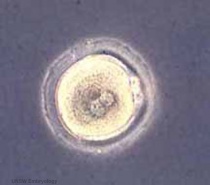
|
to this  in 9 months in 9 months
|
Objectives
- Understand the course objectives and assessment.
- Brief understanding of Australian statistical data.
- Broad overview of Human Development.
ANAT2341 Course Background 2014
I will spend the first half going through the current course design, online support and assessment criteria. This is an opportunity to ask the course coordinator questions about the course.
The first 8 weeks of human development.
Links: Course Homepage
Textbooks
Either of the textbooks listed below are recommended for this course and page references to both are given in each lecture. Both textbooks available at campus bookshop. There are additional embryology textbooks that can also be used, consult course organizer. See also Embryology Textbooks
The Developing Human: Clinically Oriented Embryology (9th ed.)
Larsen’s Human Embryology (4th ed.)
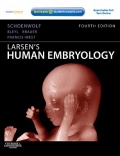
|
Schoenwolf, G.C., Bleyl, S.B., Brauer, P.R. and Francis-West, P.H. (2009). Larsen’s Human Embryology (4th ed.). New York; Edinburgh: Churchill Livingstone.
|
Publisher Links: The Developing Human: Clinically Oriented Embryology | Larsen’s Human Embryology
Recent History
1965 - Neural Crest Research Nicole Le Douarin.
1977 - Thalidomide and its affects on development. Thalidomide
1978 - First IVF baby born. In Vitro Fertilization
1996 - "Dolly the sheep" First adult somatic cell cloning using the process of nuclear transfer.
Nobel Prizes
Much of the modern history of Medicine/Embryology is documented in the Nobel Prizes for Medicine. Remember that these award dates reflect findings that have proven to be scientific key breakthroughs from earlier dates.
- 1986 discoveries of growth factors
- 1995 genetic control of early embryonic development
- 2002 cell cycle
- 2002 cell death
- 2007 embryonic stem cells
- 2010 development of in vitro fertilisation (More? Assisted Reproductive Technology)
21st Century
- 2000 - Human Genome Complete Human Genome
- 2001 talk given by Robert Winston "Engineering Reproduction: Will We Still Be Human At The End of the 21st Century".
- 2009 - Induced pluripotent stem (iPS) Stem Cells
- 2011 - First Successful Transplantation of a Synthetic Tissue Engineered Windpipe Karolinska Institute | University College London | BBC News
- "An international team designed and built the nanocomposite tracheal scaffold and produced a specifically designed bioreactor used to seed the scaffold with the patient´s own stem cells. The cells were grown on the scaffold inside the bioreactor for two days before transplantation to the patient. Because the cells used to regenerate the trachea were the patient's own, there has been no rejection of the transplant and the patient is not taking immunosuppressive drugs."
- 2012 - MRI of Childbirth
| Human Birth MRI |
| Quicktime | Flash |
- Links: Embryology History
Applied Embryology
The information is based upon data from the publication "Australia's mothers and babies 2009"[1] and is provided for educational purposes only. The original full publication is available online from AIHW Perinatal statistics series no. 25.
More births
In 2009 in Australia, a total 294,540 women gave birth to 299,220 babies. There were 296,791 live births and 2,341 fetal deaths. There was a 0.8% increase in the total number of births compared with 2008, but there was a fall in the rate of females aged 15-44 years in the whole population who gave birth (from 64.4 per 1,000 in 2008 to 63.6 per 1,000 in 2009).
- 2009 - 296,791 live births and 2,341 fetal deaths
- 2008 - 294,737 live births and 2,188 fetal deaths
- 2007 - 292,027 live births and 2,177 fetal deaths
Mothers
- Average maternal age in 2009 was 30.0 years compared with 29.0 years in 2000.
- Approximately 41.6% of women were having their first baby.
- Average age for first time mothers was 27.9 in 2009 which was 0.3 years younger than for 2008.
- Of all first-time mothers, 13.7% were aged 35 years or older in 2009, compared with 10.3% in 2000.
- ART was used by 3.6% of women who gave birth. (from available data on assisted reproductive technology (ART) where available)
Antenatal factors
Smoking while pregnant was reported by 14.5% of all mothers and by 37.0% of teenage mothers. In the 4 jurisdictions where data on the number of antenatal visits were available, 97.3% of women who gave birth at 32 weeks or more gestation attended at least one antenatal visit, with 91.9% attending 5 or more.
Indigenous mothers
Of women who gave birth during 2008, 3.8% identified as Aboriginal or Torres Strait Islander. The average age of Indigenous mothers was 25.1 years, compared with 30.1 years for non-Indigenous mothers. Over half of the Aboriginal and Torres Strait Islander mothers reported smoking during pregnancy (50.9%), compared with 14.4% of non-Indigenous women who gave birth.
Labour and delivery
About 3.8% of women who gave birth during 2009 identified as Aboriginal or Torres Strait Islander. Indigenous mothers are younger than non-Indigenous mothers; their average age was 25.3 years, compared with 30.2 years for non-Indigenous mothers. Smoking during pregnancy was reported by half (49.6%) of Indigenous mothers. Of Indigenous mothers who gave birth at 32 weeks or more gestation, 76.8% attended 5 or more antenatal visits.

|
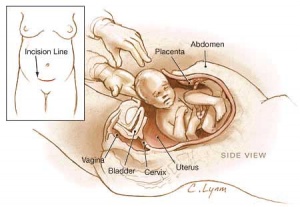
|
| Breech presentation (Galletti, 1770) | Birth caesarean |
Baby outcomes
In 2009, 8.2% of babies were born preterm (before 37 completed weeks of gestation) and 0.9% post-term (42 weeks gestation or more). Overall, 6.2% of liveborn babies were of low birthweight (less than 2,500 grams) and this nearly doubled (10.8%) among mothers who smoking during pregnancy. Less than 1.5% of liveborn babies had a low Apgar score (measure of the baby’s condition at birth). The perinatal death rate was 9.8 per 1,000 births in 2009, which comprised fetal and neonatal death rates of 7.8 per 1,000 births and 3.0 per 1,000 live births respectively.
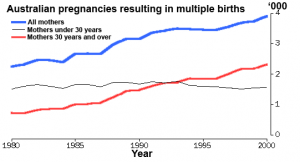
|
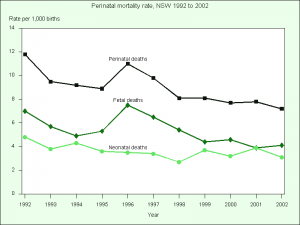
|
| Australian multiple birth data | Perinatal mortality rate NSW 1992-2002 |
Assisted Reproductive Technology
Assisted reproductive technology in Australia and New Zealand 2009.[2] 9 Nov 2011
- In 2009, there were 70,541 assisted reproductive technology (ART) treatment cycles undertaken in Australian and New Zealand.
- Of these cycles, 17.2% resulted in a live delivery (the birth of at least one liveborn baby).
- In total, 13,114 liveborn babies were born following ART treatment in 2009.
- The most important trend in ART treatment has been the increase of single embryo transfer, from 48.3% in 2005 to 69.7% in 2009.
- This trend has resulted in significant reduction of multiple delivery rate from 14.1% in 2005 to 8.2% in 2009. (More? Assisted Reproductive Technology)
References
- ↑ Li Z, McNally L, Hilder L & Sullivan EA 2011. Australia’s mothers and babies 2009. Perinatal statistics series no. 25. Cat. no. PER 52. Sydney: AIHW National Perinatal Epidemiology and Statistics Unit. Viewed 3 January 2012 <http://www.aihw.gov.au/publication-detail/?id=10737420870>
- ↑ Wang YA, Macaldowie A, Hayward I, Chambers GM, & Sullivan EA 2011. Assisted reproductive technology in Australia and New Zealand 2009. Assisted reproduction technology series no. 15. Cat. no. PER 51. Canberra: AIHW. Online Summary | PDF
Australian Developmental Abnormalities
The ten most frequently reported birth defects in Victoria between 2003-2004
- Hypospadias
- Obstructive Defects of the Renal Pelvis or Obstructive Genitourinary Defects
- Ventricular Septal Defect
- Congenital Dislocated Hip
- Trisomy 21 or Down syndrome
- Hydrocephalus
- Cleft Palate
- Trisomy 18 or Edward Syndrome - multiple abnormalities of the heart, diaphragm, lungs, kidneys, ureters and palate 86% discontinued.
- Renal Agenesis/Dysgenesis - reduction in neonatal death and stillbirth since 1993 may be due to the more severe cases being identified in utero and being represented amongst the increased proportion of terminations (approximately 31%).
- Cleft Lip and Palate - occur with another defect in 33.7% of cases.
Teratology
Teratology is the study of abnormalities of development. Some examples of historic teratology studies.
- Rubella <pubmed>1879476</pubmed>
- Thalidomide <pubmed>331548</pubmed>
- Links: Human Abnormal Development | Thalidomide | TORCH Infections | History of Teratology | eMJA - Gregg's congenital rubella
Human Development Timeline
Movies
|
|
|
|
External Links
External Links Notice - The dynamic nature of the internet may mean that some of these listed links may no longer function. If the link no longer works search the web with the link text or name. Links to any external commercial sites are provided for information purposes only and should never be considered an endorsement. UNSW Embryology is provided as an educational resource with no clinical information or commercial affiliation.
The following are links to free iBooks available for background reading.
Gray's Embryology

|
|
The Carnegie Staged Embryos
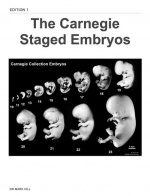
|
|
- 2014 Course: Week 2 Lecture 1 Lecture 2 Lab 1 | Week 3 Lecture 3 Lecture 4 Lab 2 | Week 4 Lecture 5 Lecture 6 Lab 3 | Week 5 Lecture 7 Lecture 8 Lab 4 | Week 6 Lecture 9 Lecture 10 Lab 5 | Week 7 Lecture 11 Lecture 12 Lab 6 | Week 8 Lecture 13 Lecture 14 Lab 7 | Week 9 Lecture 15 Lecture 16 Lab 8 | Week 10 Lecture 17 Lecture 18 Lab 9 | Week 11 Lecture 19 Lecture 20 Lab 10 | Week 12 Lecture 21 Lecture 22 Lab 11 | Week 13 Lecture 23 Lecture 24 Lab 12
Student Projects - Group 1 | Group 2 | Group 3 | Group 4 | Group 5 | Group 6 | Group 7 | Group 8 | Moodle
Glossary Links
- Glossary: A | B | C | D | E | F | G | H | I | J | K | L | M | N | O | P | Q | R | S | T | U | V | W | X | Y | Z | Numbers | Symbols | Term Link
Cite this page: Hill, M.A. (2024, May 5) Embryology Lecture - 2014 Course Introduction. Retrieved from https://embryology.med.unsw.edu.au/embryology/index.php/Lecture_-_2014_Course_Introduction
- © Dr Mark Hill 2024, UNSW Embryology ISBN: 978 0 7334 2609 4 - UNSW CRICOS Provider Code No. 00098G

